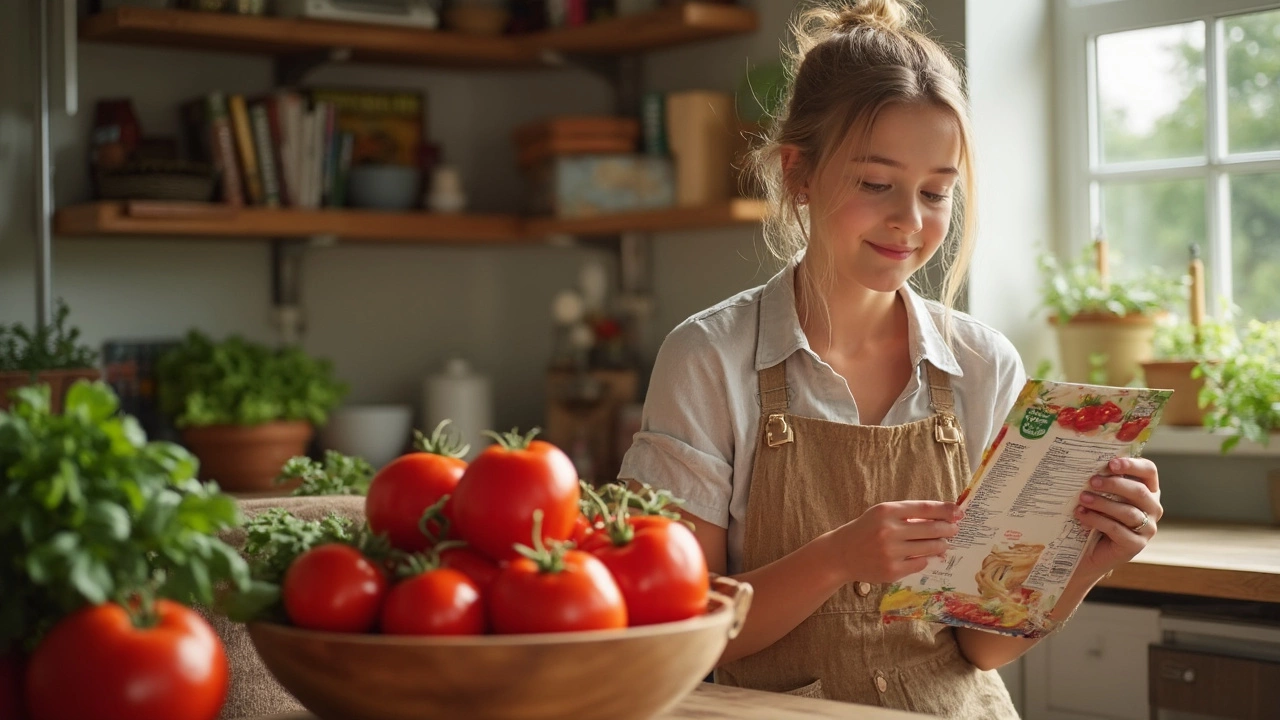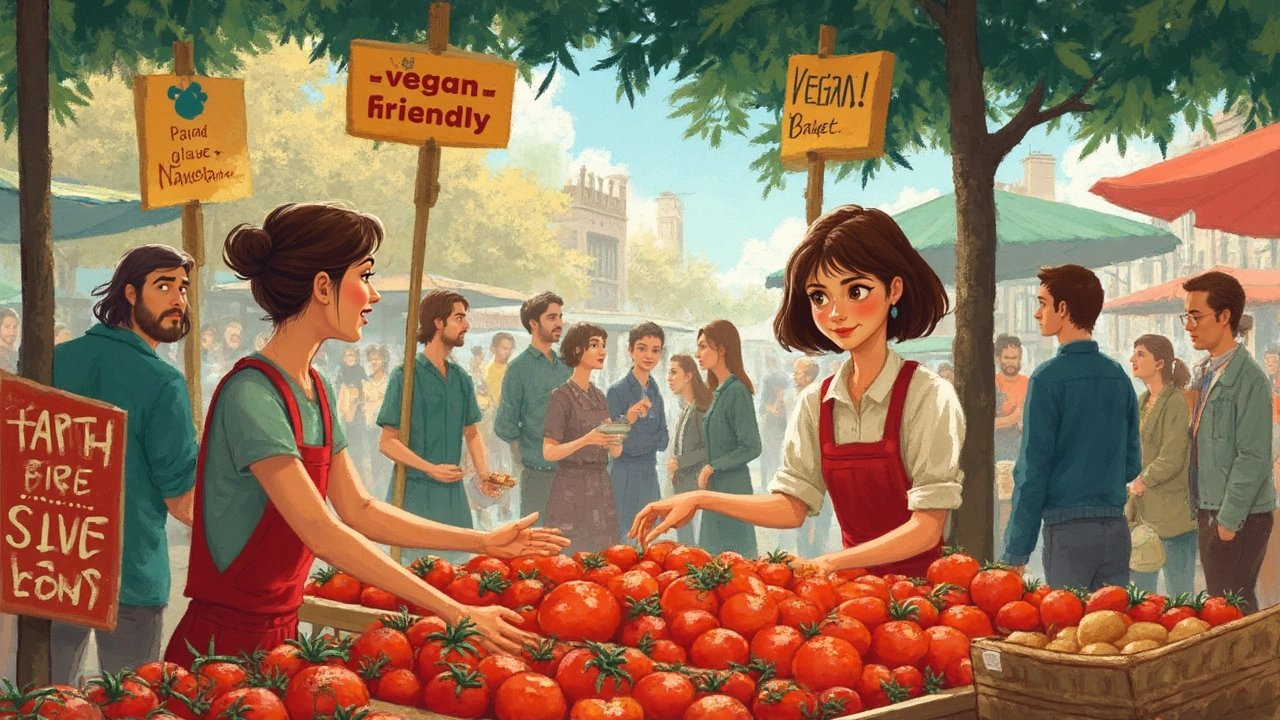
Heard the rumor that vegans don’t eat tomatoes? It pops up in some pretty wild corners of the internet, and honestly, it confuses loads of people new to plant-based eating. Tomatoes seem safe, right? They grow on a plant, you find them in salads, sauces, and, yes, even lots of desserts.
Thing is, most vegans absolutely love tomatoes. If you spot a vegan dessert with a hint of tomato—think tomato jam tarts or even chocolate-tomato cakes—it’s not a shocking loophole, it’s just creativity at work. But sometimes, certain tomato products can sneak in animal-based ingredients, especially in processed or canned foods. Those hidden extras are what make people worry.
So let’s set the record straight and make it easy: Tomatoes themselves are vegan, but you always want to peek at the label if you're buying tomato paste or a fancy jam. You might bump into sneaky stuff like whey or gelatin in processed foods. Nobody wants a lip-smacking vegan dessert ruined by a non-vegan twist, right?
- The Tomato Myth: Where Did It Start?
- Are Tomatoes Really Off the Vegan Menu?
- Hidden Non-Vegan Ingredients: What to Watch For
- Tomatoes in Vegan Desserts: Sweet Surprises
- Tips for Vegan Tomato Lovers
The Tomato Myth: Where Did It Start?
This whole tomato confusion didn’t come out of nowhere. There’s no actual rule in veganism that bans tomatoes. But somehow, the internet started buzzing with stories about vegans skipping tomatoes, and people ran with it. It’s not about the vegans themselves—most of them consider tomatoes a total go-to.
The myth has a couple roots. First, in some farming cases, tomatoes (and a few other crops like figs) can be pollinated using ways that aren’t 100% vegan. Commercial farms sometimes use bee labor to pollinate crops. For super strict vegans, this can be a gray area, because they avoid all animal use, even insect labor. But, honestly, most vegans don’t take it to this extreme—not for tomatoes, apples, or most produce.
Another factor? Confusion with other fruits. Figs freak some vegans out because certain species rely on wasps to reproduce, so that story sometimes gets tossed together with tomatoes. Add in some wild online gossip, and suddenly there’s a rumor that vegans have sworn off tomato sauce forever.
Here's a quick table showing the commonly confused foods and what actually trips up serious vegans:
| Food | Reason for Confusion | Vegan Issue? |
|---|---|---|
| Tomatoes | Bee pollination (sometimes) | Mostly fine, usually not a concern |
| Figs | Wasp pollination lifecycle | Gray area for strict vegans |
| White sugar | Bone char in processing | Can be non-vegan, depends on the brand |
| Worcestershire sauce | Anchovies | Not vegan |
The bottom line: Most people following a plant-based diet eat tomatoes without a second thought. Every now and then, someone extra-strict might skip out because of how a crop is farmed, but that's pretty rare and not connected to everyday vegan dessert recipes.
Are Tomatoes Really Off the Vegan Menu?
This myth gets tossed around a lot, but it doesn’t match reality. The truth is, tomatoes are one of the most popular foods for people following a vegan diet. You'll see them everywhere—salads, soups, sauces, salsas, and even desserts like tomato sorbet or tomato compote. They come straight from a plant, grow without the need for any animal to be involved, and are naturally loaded with vitamins C and K, potassium, and antioxidants.
So why do people think vegans avoid tomatoes? A lot of it comes down to confusion with how tomatoes are sometimes grown. In rare cases, some large-scale farms use animal-based fertilizers—like manure or bone meal—to feed tomato plants. Technically, if you wanted to avoid all products touched by animals (even indirectly), you'd need to skip most grocery store produce, not just tomatoes. That's not how most vegans eat or shop. Most focus on avoiding actual animal ingredients, not secondhand stuff from the farm.
There’s also chatter from a 2018 social media post that claimed "strict vegans can't eat tomatoes because they're pollinated by bees." Here's the deal: Tomatoes are self-pollinating. Bee pollination isn't required for them to grow. So that idea is just, well, made up.
Here's a quick look at how often tomatoes show up in vegan foods versus other diets:
| Diet Type | Tomato Use in Meals |
|---|---|
| Vegan | Very common (used in fresh, cooked, and sweet dishes) |
| Vegetarian | Very common (same as vegan) |
| Omnivore | Common, but fewer desserts and more meat-based sauces |
For anyone aiming to keep it 100% plant-based, just stick to whole, fresh tomatoes or, if you’re using canned or processed tomato products, check that ingredient list. Most of the time, you’re totally in the clear. It’s just about avoiding unnecessary animal ingredients, which rarely show up in plain tomato products anyway.

Hidden Non-Vegan Ingredients: What to Watch For
You might think everything made from tomatoes is fair game for a vegan, but not so fast. The real issue pops up with processed tomato products. Lots of canned, jarred, or packaged tomato foods can sneak in animal-based extras for texture, flavor, or shelf life. If you’re trying to keep your vegan game strong, these hidden ingredients are worth watching.
Check out this list of common animal-derived ingredients to look out for in tomato products, especially if you're planning to use them in desserts:
- Whey or milk powder: Sometimes used in tomato soup or sauces to make them creamy.
- Gelatin: A thickening agent made from animal collagen. It shows up mostly in tomato-based candy, jams, or even jelly-like desserts.
- Anchovies/fish sauce: More common in pasta sauce, but watch out—some rich tomato spreads include them for an umami kick.
- Natural flavors: Sounds safe, but this vague label sometimes hides animal-based ingredients. If it’s not clear, ask the brand or choose a certified vegan option.
- Carmine (E120): A red coloring made from crushed insects. Some tomato ketchups or sauces (especially those with a bright color) might sneak this in.
Here's a quick side-by-side comparison of popular tomato products and common non-vegan additives you might find:
| Product | Possible Non-Vegan Ingredients |
|---|---|
| Canned tomato soup | Whey, milk powder, cream |
| Tomato jelly/jam | Gelatin, carmine |
| Tomato-based sauces | Anchovies, cheese, fish sauce |
| Tinned tomatoes/puree | Usually safe, but sometimes "natural flavors" |
One easy way to stay safe? Choose products labeled "vegan" or "suitable for vegans." If you’re unsure, check the ingredients or scan for a vegan logo. Lots of brands now add allergy warnings that make it clearer to spot milk, fish, or eggs. Checking twice is way better than finding out your dessert isn’t actually dairy-free after you’ve already baked it.
Tomatoes in Vegan Desserts: Sweet Surprises
You might not expect tomatoes to show up in the dessert aisle, but they pop up way more often than you'd think. Tomatoes bring natural sweetness, moisture, and a hint of tang that works surprisingly well in sweet dishes. Some classic desserts use them as the secret ingredient.
Take tomato jam, for example. Spread it on toast or swirl it into oatmeal cookies for a boost of flavor and color. In Sicily, tomato marmalade is a real thing—they even layer it in cakes. There’s also a legit old-school American recipe for chocolate cake with tomato soup (seriously!). The soup adds richness and moisture without making the cake taste like spaghetti sauce.
Here's a quick look at how vegans are adding tomatoes into desserts that work for just about anyone (teens included who turn their nose up at veggies):
- Tomato Jam Thumbprints: Swap fruit jam for homemade tomato jam in shortbread cookies. Super easy and no dairy needed.
- Tomato Upside-Down Cake: Think pineapple cake, but with caramelized cherry tomatoes for a sweet-tart spin.
- Chocolate-Tomato Cake: Tomato puree adds moisture and a dense, fudgy texture—even Grandma won't guess the secret ingredient.
Not into baking? Blend ripe tomatoes into a smoothie with strawberries and bananas. You’ll get a burst of vitamin C and a new twist on summer treats.
| Dessert Name | Main Ingredients | Prep Time |
|---|---|---|
| Tomato Jam Thumbprints | Flour, vegan butter, sugar, tomato jam | 35 min |
| Tomato Upside-Down Cake | Cherry tomatoes, flour, sugar, plant milk | 1 hour |
| Chocolate-Tomato Cake | Cocoa powder, tomato soup, flour, sugar | 50 min |
When trying tomato-based desserts, start small. Test a spoonful of tomato jam on a cracker, or toss a few roasted cherry tomatoes into your next fruit salad. Sometimes all it takes is one experimental bite to discover a new favorite.

Tips for Vegan Tomato Lovers
If you're aiming for a completely plant-based lifestyle, knowing how to pick and use tomatoes the right way can save you lots of hassle. First off, fresh tomatoes are always a safe bet—no animal products to worry about. But once you wander into sauces, spreads, or anything jarred, it gets a bit trickier.
Want your vegans kitchen to be totally tomato-friendly? Here’s your roadmap:
- Check every label. Even tomato sauce or salsa can sneak in stuff like cheese powder, anchovy, or honey. If it isn’t a one-ingredient deal, scan the fine print.
- Look out for E-numbers. Certain food additives (like E120, which is made from insects for red coloring) appear in tomato products sometimes. Most tomato brands are safe, but never hurts to check if you’re strict about animal-free.
- Buy organic or local when possible. Some large farms use animal-based fertilizers. Organic brands tend to use more plant-based gardening methods, so they’re a safer choice if you want peace of mind.
- DIY tomato products. Skip mystery ingredients altogether and roast, blend, or simmer your own sauces and jams at home.
- Ask before you eat out. Restaurants sometimes thicken tomato-based sauces with butter or gelatin. Don’t be shy about asking how their tomato jam or compote is made, especially in desserts.
For folks worried about nutrition, here’s a quick look at how tomatoes pack a punch in a vegan diet:
| Nutrient | Per Medium Tomato | Benefit |
|---|---|---|
| Vitamin C | 17 mg | Boosts immune system |
| Lycopene | ~3 mg | Powerful antioxidant |
| Fiber | 1.5 g | Gut health |
| Calories | ~22 kcal | Light and filling |
Switching to more tomato-rich vegan desserts? Try things like roasted tomato sorbet, tomato-apple compote on oatmeal, or adding a dash of tomato jam to vegan brownies for extra zing. Tomatoes are seriously underrated in sweet treats—they help keep things moist without piling on fat or sugar.












Write a comment